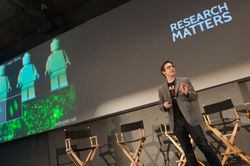 |  |  |  |
|---|---|---|---|
 |  |  |  |
 |  |  |  |
 |  |  |  |
 |  |  |  |
 |  |  |  |
 |  |  |  |
 |  |  |  |
 |  |  |  |
 |  |  |  |
 |  |  |  |
 |  |  |  |
 |  |  |  |
 |  |  |  |
 |  |  |  |
 |  |  |  |
 |  |  |  |
 |  |  |  |
 |  |  |  |
 |  |  |  |
 |  |  |  |
 |  |  |  |
 |  |  |  |
about
Inside the Pelling Lab
The Lab is interested in creating living, functional, biological objects that do not exist in nature. By physically manipulating and re-purposing living systems the Lab has discovered an astonishing ability of cells to deliberately adapt and respond to highly artificial and unusual stimuli.
What do we do?
We are interested in understanding the fundamental mechanisms through which cells sense and integrate physical information. We do this by building devices that employ nano- and micro-scale fingers, lasers, matrices and textures to literally poke, feel, stretch and confine cells while we watch how they respond.
On the other hand, we are also interested in how we might use such physical stimuli to manipulate, re-purpose and control living cells. Physical inputs might include exposing cells to mechanical forces, controlling the shape of their surroundings or simply growing cells in environments in which they are not normally found.
None of these approaches require genetic manipulation or pharmaceuticals; we simply change the physical environment to direct cellular behaviours. We have found that living cells are surprisingly adaptable to a wide variety of environments and physical stimuli that they have not evolved to cope with. This raises numerous questions about how cells are able to deal with such extremes.
The Lab is heavily informed by the biological and physical sciences, DIY, hacking, engineering, design and arts. Utilizing a combination of cell biology, molecular biology, biophysical tools, device design and computational approaches we aim to understand the fundamental mechanisms that allow cells to sense and respond to physical cues.
A variety of tools allow us to probe the force transduction and response pathways of single cells, multi-cellular aggregates and tissues at local and global scales while simultaneously controlling their mechanical, biochemical and physiological environments. Our work is enhanced by the diversity of our people and numerous collaborations across all disciplines.
Pelling Lab supporters & Partners















